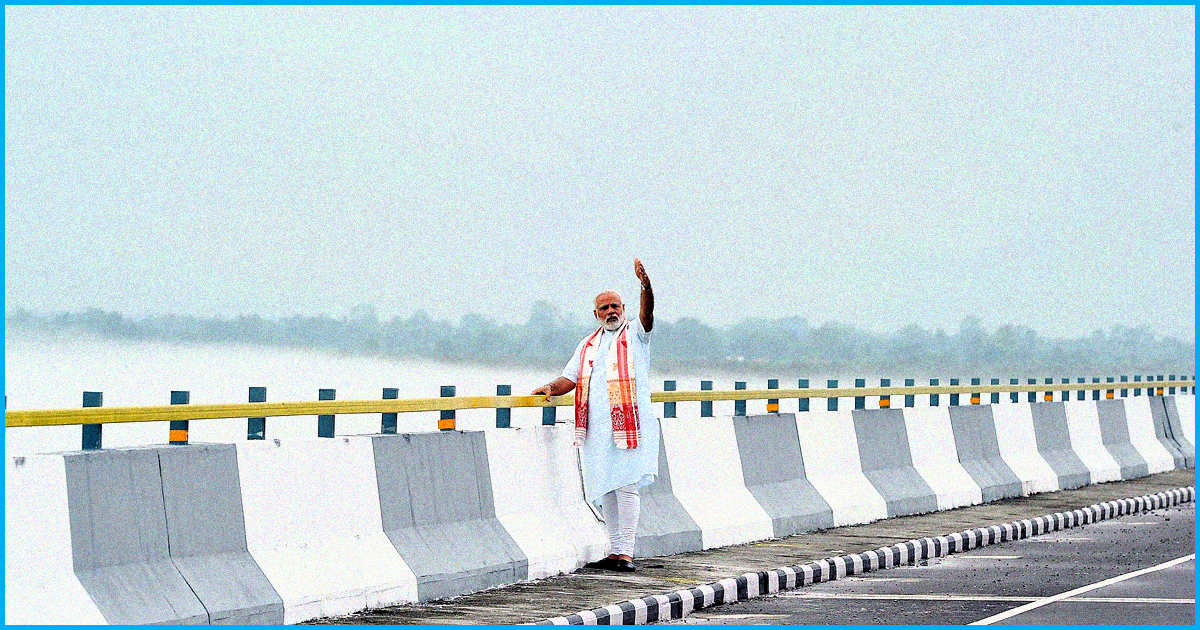On December 25, Prime Minister Narendra Modi inaugurated India’s longest railroad bridge in Assam, 21 years after the foundation stone was first laid by then Prime Minister HD Devegowda in 1997. The work for the 4.9 km behemoth Bogibeel bridge began in 2002 under then Prime Minister Atal Bihari Vajpayee.
Bogibeel bridge will improve connectivity
The bridge, which cuts across the Brahmaputra, will connect Assam’s Dibrugarh to Silapathar in Dhemaji bordering Arunachal Pradesh. It also boasts of being Asia’s second-longest raid-road bridge constructed at an estimated cost of Rs 5,900 crore, a whopping 85% more than the sanctioned estimated cost, reported LiveMint.
The bridge will cut down on travel time exponentially as the five-hour 212-km travel time from Dibrugarh to Itanagar by ferry will be reduced to less than three hours by road. Moreover, the railroad bridge will also cut down on train travel time between Tinsukia in Assam and Naharlagun in Arunachal by over 10 hours. The bridge is also India’s only fully-welded bridge for which European welding standards were followed and it has a lifespan of 120 years.
PM @narendramodi dedicates the India’s longest #BogibeelBridge in Assam to the nation. The bridge spans the River Brahmaputra between Dibrugarh and Dhemaji districts of Assam and is of immense economic and strategic significance for the nation. pic.twitter.com/syoauOHKY4
— PIB India (@PIB_India) December 25, 2018
Modi, while flagging off the Tinsukia-Naharlagun train service, has said that the Centre is committed to improving connectivity in the northeast region. Taking a jibe at the UPA government, he said that had the NDA government been in power in 2004, the bridge could’ve been completed seven or eight years ago, reported The Times Of India.
Boatmen have to find alternative livelihoods
While chief ministers of both Arunachal Pradesh and Assam lauded the inauguration of the bridge saying that it will make people’s lives easier, a group of over 40 boatmen who make a living off of ferrying people and goods across the river may face the threat of losing their livelihood. Of the 40 boats which ferry from the north and south banks of the Brahmaputra, two are run by the government, while the rest are all private.
A private ferry operator at Bogibeel ghat has been quoted by PTI as saying, “In a joint family of 12 members, I and my brother operate one boat from Bogibeel ghat. After paying Rs. 75,000 rent for the boat per annum and spending on the salaries of the boatmen, we earn around Rs. 30,000 per month.” While it took around 45 minutes or up to two hours to cross the river on boats, the new bridge will cut it short and bring it down to just 10 minutes.
According to an official of the state Inland Water Transport Department, as compared to the government boats, the private ones charged way higher and will be shifted to other ghats.
Crucial role in defence movement
Apart from improving connectivity in the region, the bridge will also likely play a crucial role in defence movement along the India-China border in Arunachal Pradesh. Pranav Jyoti Sharma, chief public relations officer for the Northeast Frontier Railway has reportedly said that the bridge will provide logistical support to the Indian Army.
The bridge finds its traces in the Assam Accord of 1985 and stood as one of the major infrastructural projects of the area. Massive infrastructural development by neighbouring China has prompted India to take this step.
Also Read: Assam: In Absence Of A Bridge, Students Cross River On Banana Stems & Aluminum Pots To Reach School











